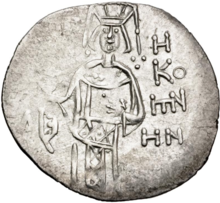| Theodora Megale Komnene | |
|---|---|
| Empress and Autocrat of all the East, of the Iberians and of Perateia | |
 Coin of Theodora, minted c. 1285 | |
| Empress of Trebizond | |
| Reign | 1284 – 1285 |
| Predecessor | John II |
| Successor | John II |
| Dynasty | Komnenos |
| Father | Manuel I Megas Komnenos |
| Mother | Rusudan of Georgia |
Theodora Megale Komnene (Greek: Θεοδώρα Μεγάλη Κομνηνή, Theodōra Megalē Komnēnē), (before 1253– after 1285), was Empress of Trebizond from 1284 to 1285. All Michael Panaretos tells us about her is that she was a daughter of Emperor Manuel I of Trebizond by Rusudan, a Georgian princess.[1] Although some consider her Manuel's second wife, Michel Kuršanskis has argued that Rusudan may have been simply his mistress.[2] Kuršanskis also notes that the evidence is insufficient to determine if Theodora was identical with one of the princesses of Trebizond mentioned in the Chronicle of Bishop Stephanos who married a noble or the king of Georgia, or if she had been a nun — much as Anna Anachoutlou was before her usurpation in the following century.[3]
In 1284, with the help of Georgian King of Imereti, David VI Narin she managed to seize the crown from her half-brother, Emperor John II.[4] John II may have taken refuge in Tripolis.[5] Shortly afterwards she was defeated and John regained his throne, but she had managed to reign long enough to have minted her own coins. A few types of silver aspers and bronze nomismas are evidence that she was the only Empress of Trebizond to have coined money.[6] Her fate after John's restoration is unknown. She fled Trebizond in 1285 and disappears from history thereafter; she might have gone into exile in Georgia, the homeland of her mother.
- ^ Michael Panaretos, Chronicle, ch. 8. Greek text and English translation in Scott Kennedy, Two Works on Trebizond, Dumbarton Oaks Medieval Library 52 (Cambridge: Harvard University, 2019), p. 7
- ^ Kuršanskis, "L'usurpation de Théodora Grande Comnène", Revue des études byzantines, 33 (1975), pp. 198f
- ^ Kuršanskis, "L'usurpation", p. 200.
- ^ William Miller, Trebizond: The last Greek Empire of the Byzantine Era: 1204-1461, 1926 (Chicago: Argonaut, 1969), p. 30
- ^ Kuršanskis, "L'usurpation", p. 203.
- ^ Warwick Wroth, Catalogue of the Coins of the Vandals, Ostrogoths and Lombards and of the Empires of Thessalonica, Nicaea and Trebizond in the British Museum (London: Trustees of the British Museum, 1911), pp. lxxx, 277 has only an example of the asper; Otto Retowski, Die Münzen der Komnen von Trapezunt, 1910 (Braunschweig: Klinkhardt & Biermann, 1974), pp. 132-134 shows two examples of both asper and nomisma.